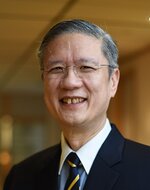With around 4.8 million inhabitants in an area of just 700m2, Singapore is the smallest country in Southeast Asia. The prosperous insular state nevertheless impresses with its continually strong economic growth – and a high market potential for LASIK: 85% of Singaporeans are short sighted. It is the consistent implementation of safety and quality that makes Jerry Tan Eye Surgery so unique in this area – and has allowed it to become a role model for many eye laser clinics in other countries. It was then natural for this clinic, which is located centrally on Orchard Boulevard in Singapore, to acquire and use SCHWIND AMARIS 750S technology.
Cost plays an important role in the decision of Singaporeans to have eye laser treatment, and even though a LASIK treatment at Jerry Tan Eye Surgery, at €4,000 for both eyes is the most expensive in the whole of Southeast Asia, his clinic appointments are continuously in high demand from patients. This is primarily due to word of mouth, i.e. recommendations from satisfied patients. Expectations are high and patients not only demand good daytime vision, but also expect excellent vision in dim light and as well as with night vision. "We stand out from the high volume standard LASIK centres, because we offer premium quality in all treatment steps and with our technology and service."
Proven expertise
"We also have proven expertise in the dealing with complications. We advertise these unique selling points once to twice a year in the daily Singapore newspapers. The main concern of LASIK patients is possible complications during or after treatment. For example, many patients have heard about night vision problems after LASIK.
Our studies on night vision problems and their cures help reassure patients and give them a sense of safety and security", says Dr. Jerry Tan, founder and head of the clinic. Overall a demanding mission, which the eye surgeon fulfils perfectly thanks to his longstanding experience and expertise.
LASIK Pioneer in Singapore
In 1996, he was the first eye surgeon in Southeast Asia to carry out LASIK treatments. Dr. Tan continued to make a name for himself as a pioneer, with work on wavefront and topography guided corrections. He trained in the USA and England and worked for 11 years in Singapore public eye hospitals, he then left government service to set up his own clinic in 1995. Presently with a team of five optometrists, five nurses, five administrators and a clinic manager – and since October 2010 a further eye surgeon – he offers a wide range of treatments: annually approx. 800 LASIK treatments, 250 cataract surgeries, 10 corneal transplants, 30 glaucoma operations and more than 200 treatments with Argon or YAG laser treatments are carried out in the clinic. Dr. Tan has carried out more than 12,000 LASIK treatments since 1996. Even without investing in advertising the clinic has an impressive patient flow. Therefore, marketing the clinic services abroad is not a priority. However, Dr. Tan and his team are currently considering promoting their activities in neighbouring and populous Indonesia, which is just an hour by plane away from Singapore.
Minimum re-treatment rate
The already low re-treatment rate has continually decreased further in the last few years and in 2010 was less than 1% – an obvious quality indicator.
Exclusively Dr. Jerry Tan carries out the LASIK treatments and supervises patients during the whole process – from the evaluation of the pre-LASIK assessment right up to every scheduled follow up. He personally calibrates the SCHWIND AMARIS 750S before each case. With LASIK Dr. Tan follows a unique concept: initially the non-dominant eye is treated and then the dominant eye is treated one to two weeks later.
"That way we can adjust to individual variations in the healing process and make our results more precise. This method, I feel, is safer for the patients. Simultaneous treatment of both eyes is more convenient for the doctor, but also brings the risk of a bilateral inflammation", says Dr. Tan.
Also in other respects a great deal of importance is placed on the best possible patient care. For example, nervous patients can run through the complete treatment as a "full dress rehearsal" one day before the surgery. After the treatment and at least one hour of rest in the clinic, a free limousine service will take the patients home. And finally, on the same evening a senior staff member will contact the patients by telephone and enquire in detail about their post-operative progress.
99% Corneal wavefront
Since February 2011, Jerry Tan Eye Surgery has been using the SCHWIND AMARIS 750S. "Until now, the system has exceeded all our expectations. We are particularly pleased with the performance of the eye tracker and the flexibility of parameter setting for asphericity, size of optical zone and ablation depth. In my opinion, it is the combination of the ablation speed, the quick eye tracker and the static cyclotorsion control, which makes treatments with the corneal wavefront so highly accurate“, says Dr. Tan.
The initial results show that the astigmatic correction especially for high astigmatism cases is extremely precise. The eye surgeon has carried out 99% of all LASIK treatments with corneal wavefront: "The procedure allows me to obtain larger optical zones with gentle transition zone gradient. Coma is common and a ‘natural’ higher order visual defect in our ethnic Chinese patients’ cornea. The aim of the best possible post-LASIK vision quality is achieved here using the corneal wavefront technology to correct this.“ Additionally, the corneal topography is very precise. With the static cyclotorsion control, the axis orientation of the eye can be predicted precisely and no astigmatism is induced in the treatment.
Dr. Tan continually invests in the newest technology. Since 2010, he has been offering his patients NeuroVision programme. It accelerates the neural adaptation of the brain after a LASIK treatment with the corneal wavefront technology. The programme is based on research which was carried out for the treatment of amblyopia, and trains the visual cortex to perceive better contrast sensitivity. The patients start computer based visual training one developed new solutions. In certain cases, they explained precisely why my ideas could not work in practice. I believe that I will be working with SCHWIND for many years and I am very glad to have met such a great group of people, so interested in advancing the art and science of refractive surgery.”






